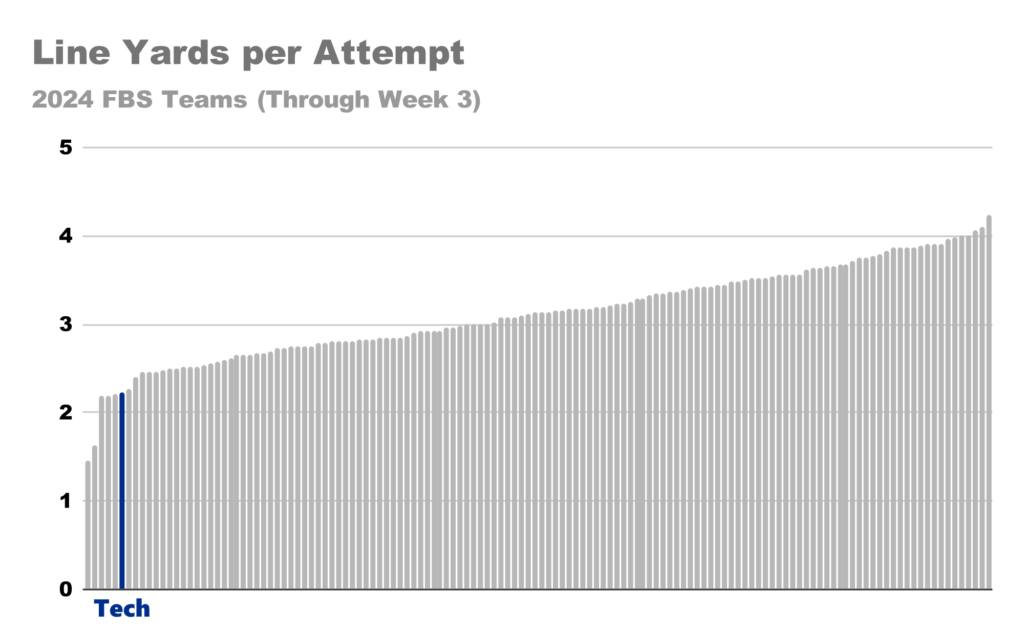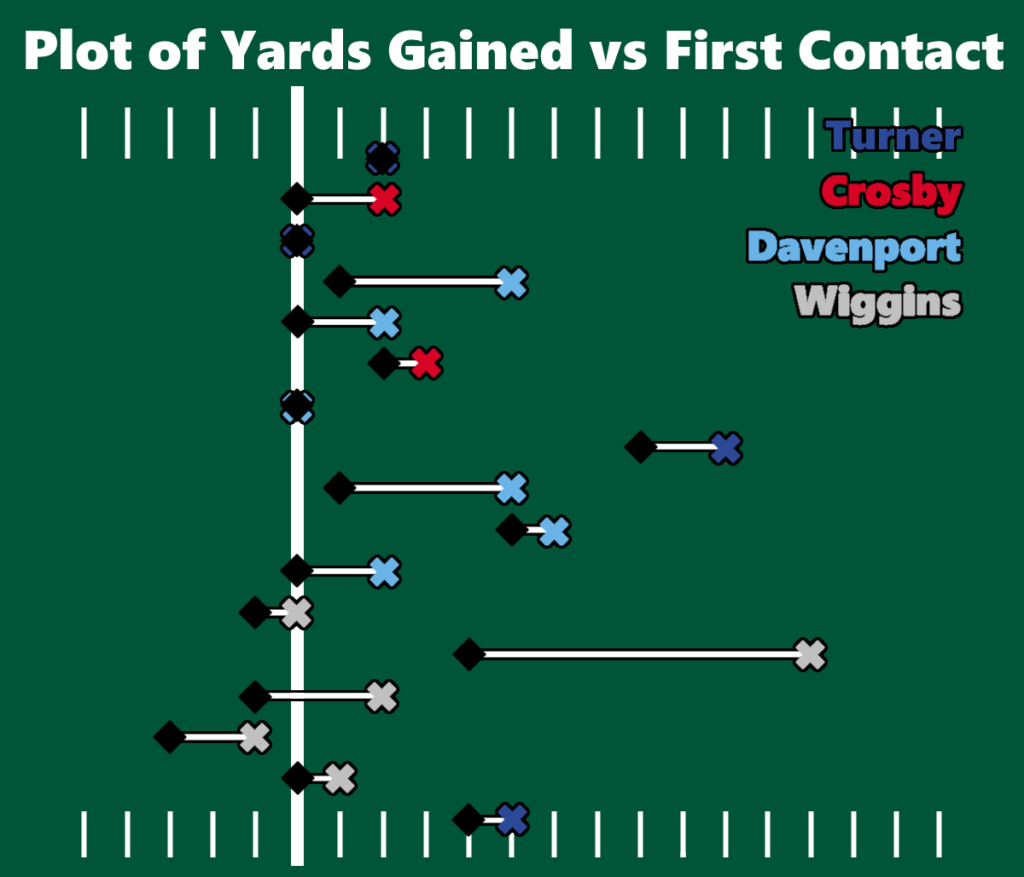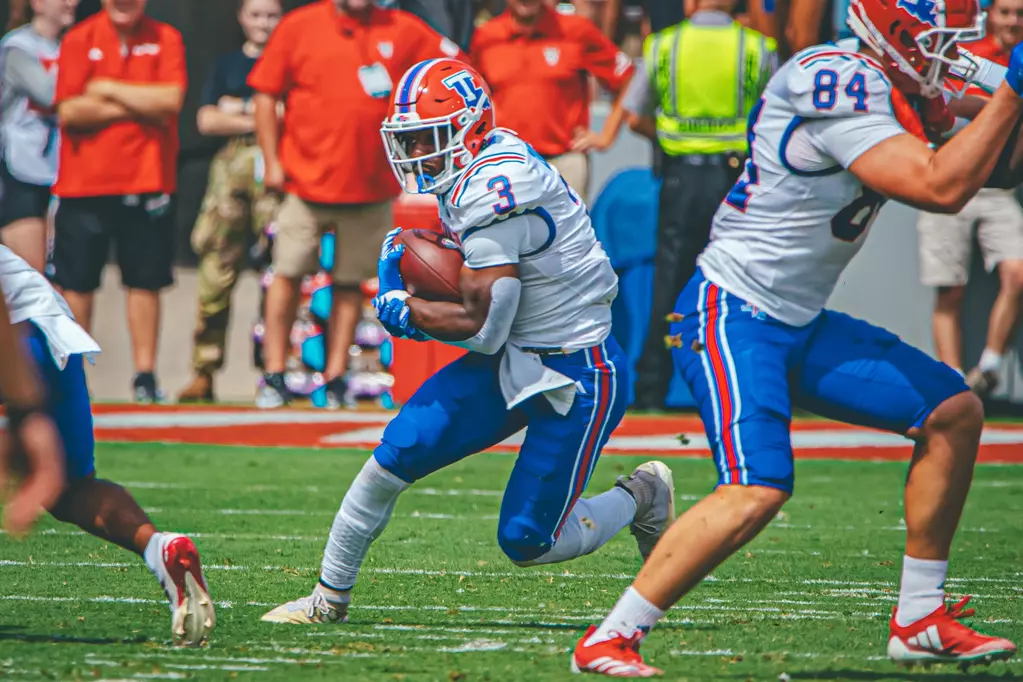There’s no sugarcoating it – the Louisiana Tech running game has struggled out of the gate in 2024. With just 71 rushing yards per game (the 8th fewest in the nation), an alarming 2.4 yards per carry (7th worst), and only 4 first downs per game achieved on the ground (8th worst), it’s clear that something isn’t working.
When asked about these struggles in this week’s press conference, Head Coach Sonny Cumbie focused primarily on the efforts of the running backs. He mentioned Marquis Crosby’s nagging injury and Omiri Wiggins’ tendency to want to bounce runs outside. However, what Coach Cumbie didn’t address was the glaring problem: run blocking. After watching Saturday’s game, it became clear that this is where the issues begin.
To grasp the extent of Tech’s rushing woes, let’s look at an advanced stat: Rushing Play Success Rate.

This metric measures how often the Bulldogs’ rushes are considered “successful,” which includes instances where the offense:
- Scores
- Gains at least 50% of the needed yards on a 1st down
- Gains at least 70% of the needed yards on a 2nd down
- Gains all the necessary yards on 3rd or 4th down
With just 15 successful rushes on 52 attempts this season, Tech’s run-play success rate stands at a dismal 28.3%, ranking as the 3rd worst in college football. For context, the 2023 Bulldogs, while not a great rushing team either, still managed a 41.9% success rate, placing them 53rd in the country.
To figure out who to blame for these woes, let’s look at Line Yards, a metric that evaluates the effectiveness of the offensive line by assigning different weights to various parts of a rushing attempt:
| Category | Distance | OL Contribution |
| Negative Yards | < 0 yards | 120% |
| Line Yards | 0 – 4 yards | 100% |
| Second Level Yards | 5 – 10 yards | 50% |
| Open Field Yards | 11+ yards | 0% |
For example, consider Omiri Wiggins’ 12-yard rush on Saturday. The offensive line is credited with 7 of those yards (the first 4 gained plus half of the next 6), while Wiggins receives credit for the remaining 5 yards.
Based on this rubric, the Tech offensive line has failed the Bulldog running game:

Out of 51 rushing attempts this year, ball carriers have reached the second level only 10 times and the open field just 3 times. Notably, one of those open-field rushes was an improvised scramble by Blake Baker—not even a designed run!
Another way to approach this issue is to chart where each Tech rusher was first contacted and where they were tackled. The farther downfield the rusher is before contact, the better the offensive line is performing. Meanwhile, the distance a running back gains after contact reflects their ability.
This isn’t an official stat, so I can’t compare Tech’s numbers to other teams, but I did go back and re-watch the NC State game and plotted each rush attempt:

(Diamonds represent where contact was made and “x”s represent where the runner was tackled.)
Only once did a rusher make it five or more yards past the line of scrimmage before being contacted. And on that play, Omiri Wiggins gained an additional eight yards and picked up a first down.
While we can certainly point fingers at running backs for mistakes within their control – like Crosby’s red zone fumble in the Nicholls game – the reality is that for nearly every other rush, the offensive line has been doing them a disservice.
It doesn’t matter if it’s Crosby, Davenport, or even Princeton Cahee (yes, that’s a real Tech RB) carrying the ball; without the offensive line creating holes, the Bulldogs will struggle to establish any kind of run game.
So, it’s disappointing to hear Coach Cumbie in the Tuesday press conference say things like, “We’ve got to get some juice going in that (running back) room” and “We created more space (against NC State).”
No coach, we did not. When 11 of the 17 rush attempts result in runners being hit within a yard of the line of scrimmage, the issue is the blocking, not the backs.
Maybe that’s solved with scheme. Maybe that’s solved with playcalling. Maybe there is no solution for this 2024 team and the offensive line talent we have on our roster has doomed any chance we have at creating an effective run game.
Regardless of if it’s any of those reasonings, it’s not fully on the running backs.

